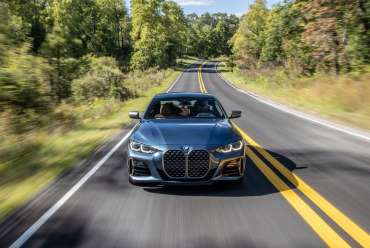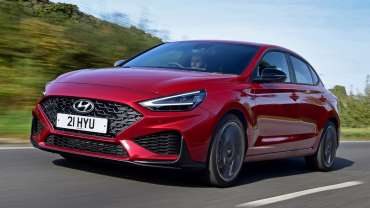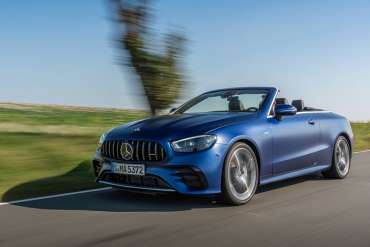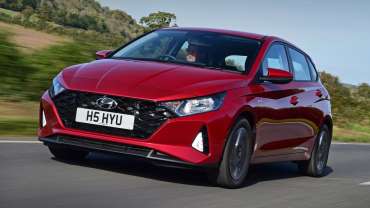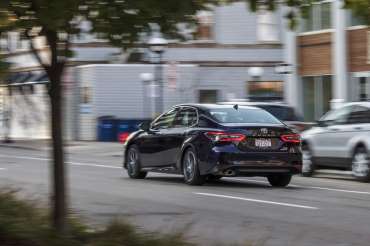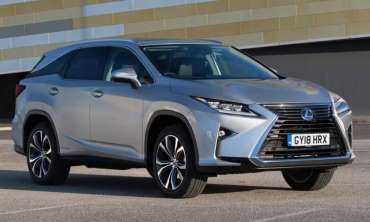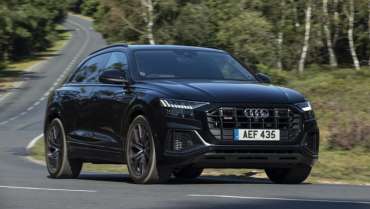
Worldcarblog.com
2021 BMW M440i xDrive Noses Away From Its Roots
The M440i xDrive's spectacular inline-six can't quite make up for the rest of the car.
Traditionalists will say the new 4-series maintains only a passing resemblance to a BMW, like an unlicensed rendering in a video game. They'll also note the attention-snaring vertically oriented grille. But what's most disappointing is that it's not as good to drive as we'd expect a sporty BMW coupe to be.
The 4's redesign catches it up to the current G20-generation 3-series. Although the two cars share a 112.2-inch wheelbase, the coupe is an inch or two longer, wider, and lower and has a wider rear track. That growth brings a larger rear seat that's tolerable for average-size adults. In profile, the 4 looks almost like a scaled-down 8-series, yet unlike the 8, it doesn't look quite so much like a Ford Mustang.
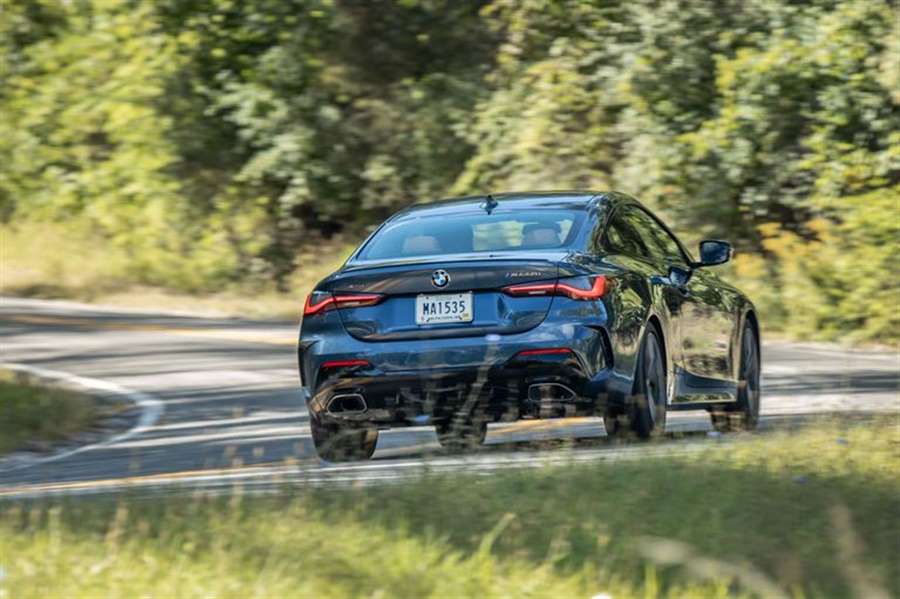
The update adds to the 4's curb weight. It's now basically a two-ton car in the top M440i xDrive trim, with our test car placing a substantial 53.8 percent of that mass on its front wheels. Even with 19-inch Michelin Pilot Sport 4S summer tires (18s with all-seasons are standard), it managed only 0.91 g of skidpad grip, and understeer dominates. We've recorded more stick from the newest 3-series and even some family sedans, although our car did stop from 70 mph in a short 149 feet.
The M440i's variable-ratio steering is short on tactility and has an almost rubbery buildup of force as you turn off-center. The rack's rather quick ratio only amplifies its artificial feel. Factor in the compliant ride from the adaptive dampers and the 4 has veered into grand-touring territory. It'll still happily hustle down a challenging road, but the experience isn't as satisfying as it used to be.
The M440i xDrive is still quick—3.8 seconds to 60 mph—thanks to the 382 horsepower from BMW's awesome turbo 3.0-liter inline-six. A new 48-volt motor-generator adds some pounds yet contributes up to 11 horses to assist the engine before the turbo wakes up. Lag is nicely mitigated as proven by the fleet 4.6-second time in our launch-free five-to-60-mph test. Sadly, a manual is no longer offered, but ZF's ubiquitous eight-speed automatic swaps gears as sweetly as ever.
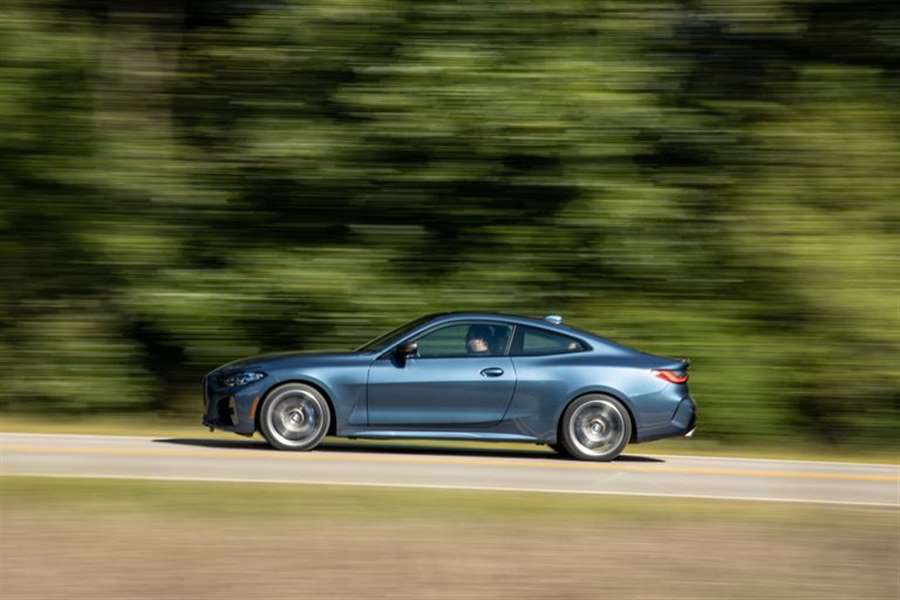
This being our first turn with the new 4, we're hoping other versions offer a closer connection. Our hope is the four-cylinder 430i model, which comes standard with non-variable steering and passive dampers, will carry the BMW dynamics torch of yore. It is currently the only 4-series available with rear-wheel drive, though a rear-drive six-cylinder model will be added later.
The fiery performance of the latest M3 and M4, both of which adopt similar vertical grilles, should help us acclimate to the controversial design. But the softer character of the M440i xDrive makes it tough to overlook the 4's new face.
Source: caranddriver.com
New Hyundai i30 Fastback N Line 2020 review
The new Hyundai i30 Fastback N Line looks great, but what's it like from behind the wheel? We find out...
The Hyundai i30 N Line Fastback certainly adds a little more excitement to the compact family car class, but behind the looks is a car that falls short in key areas. The sluggish dual-clutch gearbox and overly firm ride compromise the overall package and its ability as a family car. More sensibly-priced options lower down the range make for better family transport, while those wanting the looks and performance should try to find the extra cash for the fully-fledged N model.
Despite having been around for over 13 years - now half way into its third generation - the Hyundai i30 has never really gained the notoriety of its class rivals, such as the VW Golf or Ford Focus. It’s a competent, comfortable and affordable family car but remains a slightly left field choice in its class.
Hyundai has attempted to address that as part of the car’s mid-life update by introducing a new 158bhp 1.5-litre Fastback model that only comes in the firm’s racy N Line trim. The visual updates are minor but certainly go some way into making what was a rather forgettable-looking family car into something a bit more striking.
A new LED lighting signature and reshaped bumper sharpen up the front end, while gloss black trim on the lower edge of the bodywork and new 18-inch alloy wheels give a more purposeful look to the car. As a Fastback, the N Line makeover really does look the part.
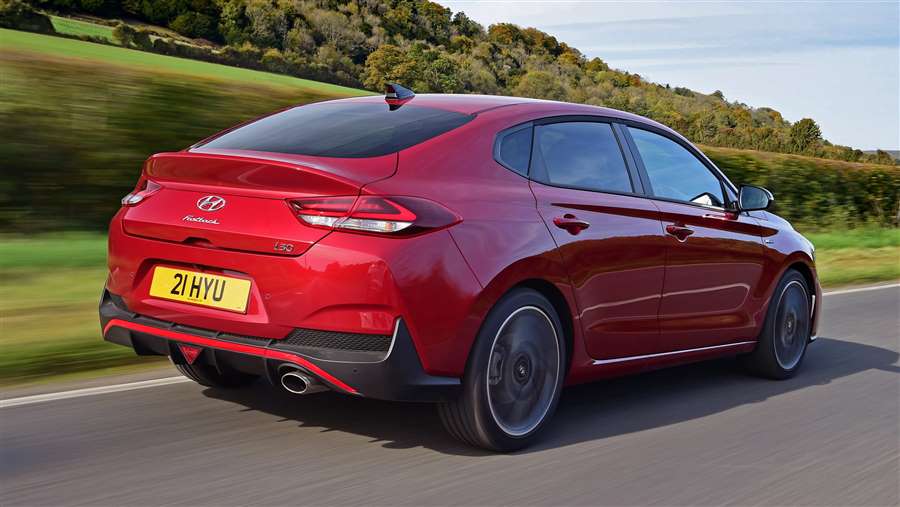
The engine is also new; the previous 1.4-litre four-cylinder turbo has been ditched in favour of a new 1.5-litre T-GDi that develops 159bhp and 253Nm of torque. Performance figures are brisk if not blistering, with Hyundai claiming an 8.8-second sprint from 0-62mph and a top speed of 130mph.
In our test car, the engine drives the front wheels through a seven-speed dual-clutch automatic gearbox. Hyundai’s six-speed Intelligent Manual Transmission is also available, which brings with it a £1,200 saving.
Opting to pocket that extra cash and go for the manual is probably a good idea, as on this evidence, the seven-speed DCT is one to avoid. Whether pulling away from a junction, accelerating to overtake on a dual carriageway or even if you’re just dawdling around town, the gearbox is sluggish and laboured at making changes. Despite being an N Line model, there are no steering wheel-mounted paddles for you to operate the gearbox with yourself, either.
The engine is smooth enough, assisted by the integrated 48-volt mild hybrid technology, but always hampered by the gearbox. However, it’s pretty efficient, nudging above 40mpg over a mix of roads on our test.
There might not be lots of power, but the chassis lets you make the most of it. The steering is part of a responsive front-end that resists understeer well and allows you to maintain momentum through a series of bends.
However, another gripe is the ride quality - or lack of it. Hyundai has seen fit to match the car’s racy new exterior with an equally sporty ride, but this i30 N Line doesn’t possess anywhere near the level of performance necessary to justify such a stiff suspension setup.
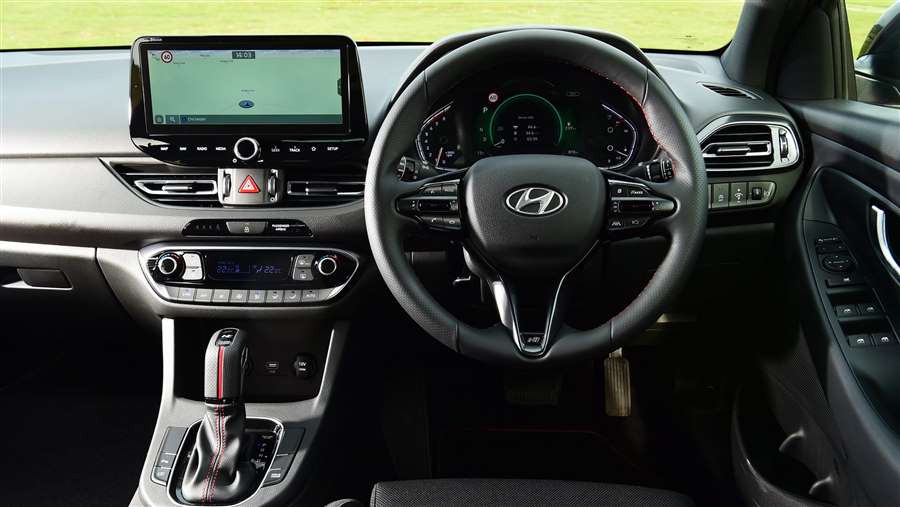
The car constantly fidgets and fights with the surface as you drive along, crashing over bumps that it really should soak up. The dampers are also passive - unlike the proper N model - so even as you cycle through the driving modes, there’s no improving the quality of the ride.
Inside, there have been some welcome tech updates, Hyundai adding a new 10.25-inch widescreen infotainment to the dash that’s compatible with both Apple CarPlay and Android Auto. Wireless smartphone charging and Hyundai’s new Bluelink telematics system, which beams real-time traffic and weather data to the car, have also been added.
A sticking point for most buyers, and what’s likely to make this i30 N Line quite a rare sight on UK roads is its price. At almost £27,000 tested here it’s only a few thousand short of the fully-fledged N car, which has the performance to match its looks. Over a three-year PCP deal, that’s likely to equate to only a few pounds extra per month.
Source: autoexpress.co.uk
2021 Mercedes-AMG E53 Cabriolet Delivers Both Speed and Grace
A freshened face and additional features adorn AMG's updated droptop E-class, but its high-tech inline-six remains as sweet as ever.
The hierarchical nature of model positioning means it is easy to view the 2021 Mercedes-AMG E53 as less desirable than the AMG 63 S sitting above it in the E-class range. Yet, such a judgement is unfair. The considerable talents of AMG's gently electrified six-cylinder give it a different character than the range-topping V-8 but one that's almost as equally compelling. In those variants where both powerplants are offered, it is entirely justified to prefer the smaller engine on grounds other than sheer parsimony. With the stylish E-class cabriolet, however, the point is moot. The AMG E53 is where the convertible tops out.
Some will bemoan AMG's continued refusal to combine the sonorous muscularity of its twin-turbo 4.0-liter V-8 with the cabriolet body. But the electrically assisted 3.0-liter inline-six of the AMG E53 proves almost perfectly suited to the car's laid-back driving manners. A mid-term facelift for 2021 hasn't wrought any significant mechanical revisions—power and torque figures remain unchanged—but it has brought more toys and revised styling to the range-topping cabriolet.
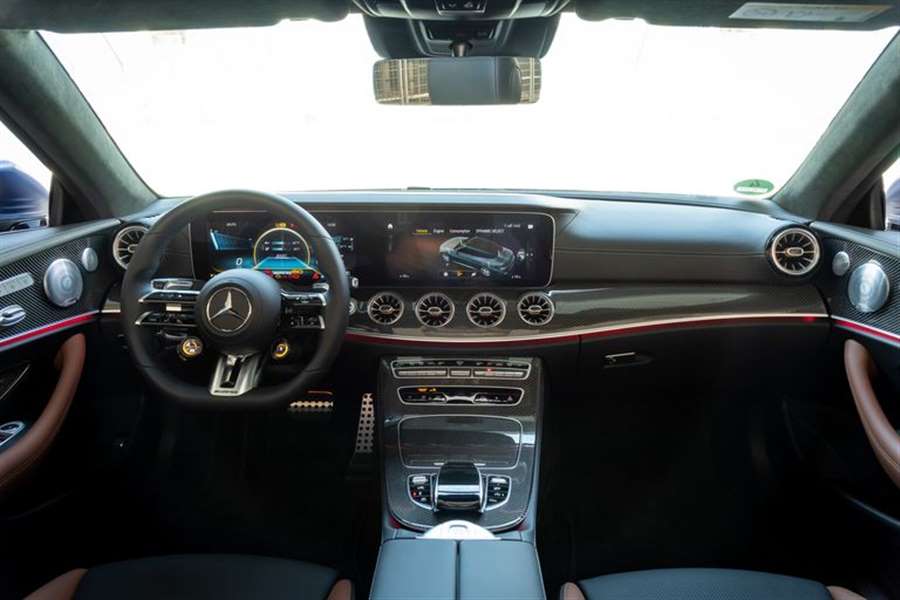
As with the E-class sedan and wagon, the cabriolet and closely related coupe get a heavily revised front end with new headlights and a radiator grille apparently inspired by the W194 300SL racer that won the Carrera Panamericana in 1952. Narrowed at the top and wider at the bottom, this is effectively an inverse of the pre-facelift grille and one that we think better suits the car. Changes at the rear end have been more limited, the E-class cabriolet (and its coupe counterpart) getting taillights with new internal elements. As before, the AMG E53 gets quad exhaust pipes beneath the rear bumper. The lesser E450 makes do with slightly squashed-looking dual exhaust tips.
More obvious changes are evident in the cabin, which remains spacious and extremely well-finished but which has migrated to the latest version of Mercedes's MBUX infotainment system. This is certainly crisper looking than the old setup and adds high-tech features like augmented-reality navigation, which superimposes direction-pointing arrows onto a live video feed when approaching intersections, but we found the system lacking in intuitive smarts and sometimes complicated to operate. Mercedes also gave the E53 a new four-spoke steering wheel to provide real estate for a proliferation of touch-sensitive controls, many of which replicate functions still served by surviving pre-facelift buttons. Buyers will doubtless get used to the complexity—or shortcut it with the smart "Hey, Mercedes" voice assistant—but we are increasingly nostalgic for the recent past when Benz's user interface was both simple and intuitive.
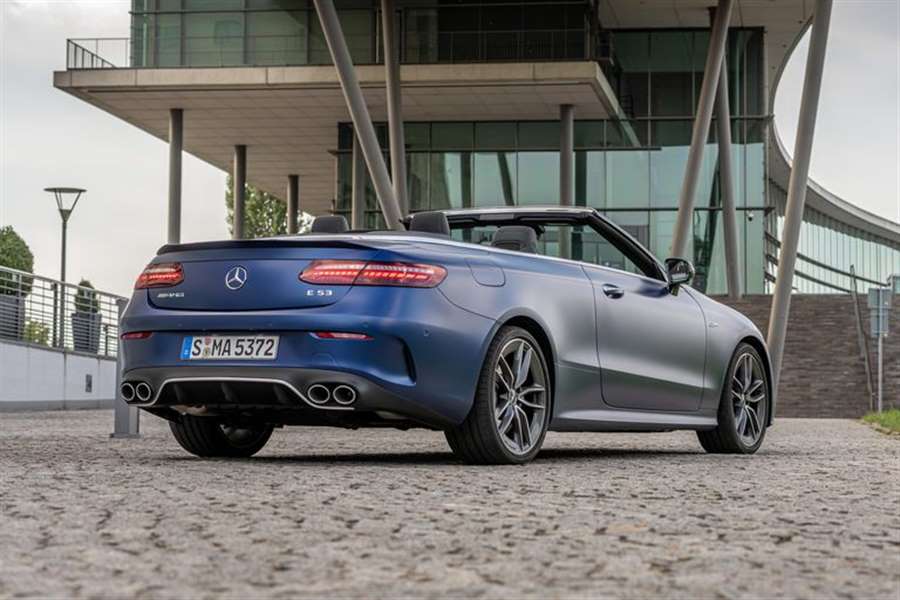
Beyond mild ergonomic niggles, the rest of the driving experience impresses all the way. The E53 powertrain continues to use a very clever 3.0-liter inline-six that has both a conventional exhaust-driven turbocharger and an electrically powered 48-volt compressor that adds boost at lower engine revs. The six is paired with a substantial integrated starter-generator that, although it can't power the car by itself, is able to add up to 21 horsepower and 184 pound-feet of torque to the combustion engine's output of 429 horsepower and 384 pound-feet. (The lesser E450 uses the same engine and starter-generator but lacks the e-turbo.)
The powertrain's complexity remains effectively invisible. All the E53 driver will experience is the combination of effortless low-rev muscle—with a total absence of detectable lag—and an impressively bristly top end. No, the six-cylinder can't match either the firepower or theatrics of the E63 S, but it is still able to deliver forceful acceleration when unleashed. The last E53 coupe that we tested blasted its way from zero to 60 mph in just 4.1 seconds, and we expect about the same for the slightly heavier cabriolet. Only at high speeds does the E53 start to feel anything less than blisteringly quick. On a stretch of limit-free German autobahn on our test route, the rate of acceleration fell away above an indicated 125 mph, a speed at which the E63 S sedan kept pulling at a barely diminished rate. While obviously lacking a V-8 soundtrack, the E53 makes some impressively muscular noises under hard use, with the Sport and Sport Plus modes allowing for some pops and crackles on upshifts and when the accelerator is lifted at higher revs.
The punchier dynamic modes sharpen the rest of the E53 driving experience, too, although not one turns it into a true sports car. Air springs and adaptive dampers are firmed up in the more aggressive settings but not sufficiently to corrupt the cabriolet's ride. Nor does the body control feel wayward in Comfort mode, the cabrio's 4600-pound mass kept in check over the roughest surfaces we could find. The weight is more obvious when asking the car to change direction quickly, and with the cabriolet's roof stowed we did notice slight evidence of the car's weakened structure, the rearview mirror vibrating slightly over certain road surfaces. The cabriolet's steering delivers crisp cornering response, although little natural feel passes beyond the generous power assistance. Traction from the quick-acting 4Matic all-wheel-drive system is impeccable on dry pavement. It takes an unsympathetic level of abuse to persuade the E53 to relinquish any rear-end grip.
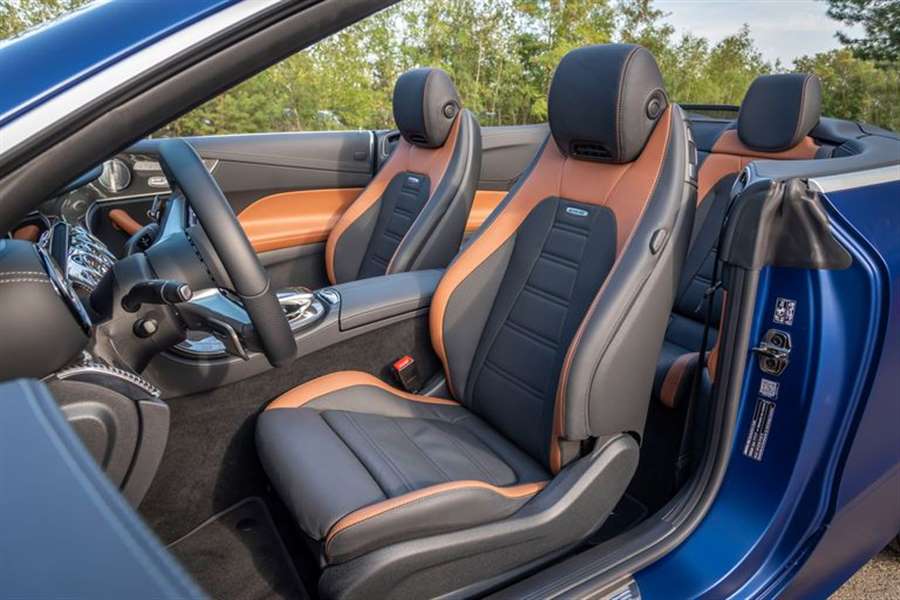
The E53's hybrid powerplant remains almost perfectly suited to the cabriolet's dynamic demeanor—rapid but relaxed, adding character without dominating the experience. Even cruising at speed with the roof folded, the E-class cabrio's cabin is impressively free of drafts or buffeting. The Airscarf system directs hot air to the top of the seats, making it possible to enjoy top-down driving in conditions that would be too chilly for most convertibles. The nine-speed automatic gearbox is also smoother at lower speeds than on V-8-powered models, where AMG replaces the torque converter with a wet-clutch pack.
Luxurious cabriolets have been part of Mercedes's offerings in the United States for as long as the brand has been selling cars here, but that might not be the case for much longer. We know that the future of all the brand's cabrios (and conventional coupes) are under review in the face of sliding sales. Losing a car like this would be a huge shame. The E53 continues to feel like a high point for both its brand and its wider genre.
Source: caranddriver.com
Hyundai i20 hatchback review
"The Hyundai i20 is more fun than before and lots of tech has been added as standard"
The supermini class is one of the most hotly contested in Europe but that's not stopped the Hyundai i20 winning praise in the past. The previous model was always a sensible choice, thanks to its reliability, practicality and low running costs. The new version continues this theme but is more fun to drive too.
That's important in a class that contains not only the Ford Fiesta but the latest Renault Clio, which is also better to drive than before. The latest i20 has been developed with a hot ‘N’ version in mind, and feels firmer as a result.
Just one engine is available at launch, so it's a good job it’s likely to be the pick of the range when others arrive anyway. The 1.0-litre three-cylinder turbo has 99bhp, which is peppy enough and feels smooth and refined. It's also fitted with mild-hybrid tech that recoups energy as the car slows down, boosting efficiency by powering the car's systems and bolstering acceleration.
The result is a competitive 54.3mpg fuel consumption figure with 118g/km of CO2, which is also helped by an innovative system that can decouple drive from the gearbox when you come off the throttle, allowing the car to 'coast' with the engine temporarily switched off. If that sounds jarring, know that the i20 has one of the smoothest mild-hybrid setups we've tried so far.
The i20's interior is a bit of a mixed bag but there’s more good than bad. On the positive side, there's lots of tech and space. Hyundai has fitted a new eight-inch touchscreen to the left of the instrument binnacle, with clear graphics, and there's a 10.25-inch digital instrument panel. Features like air-conditioning, Android Auto and Apple CarPlay also come as standard in the entry-level SE Connect trim. There are almost no options available but Premium trim adds LED lights, folding mirrors, auto wipers, heated front seats and even a heated steering wheel, along with 17-inch alloy wheels. Ultimate gets big-car features like keyless entry, a Bose sound system and contrasting roof colour.
What's slightly disappointing is some of the interior materials, because while the swooshes across the dashboard look quite good, there's a lot of hard and scratchy plastic lower down in the car. There's more chrome or gloss-black trim in the Fiesta and Clio, and even cheaper plastics tend to be patterned to make them look more attractive.
There are no worries about space, with enough room in the back for two six-foot adults, which is about as much as you can ask for in a supermini. Its 352-litre boot is also plenty big enough for a car in this class, easily beating the 311 litres of the Fiesta. Hyundai has also fitted the i20 with plenty of safety kit, clearly wanting to better the four-star result of the outgoing i20. Its 'SafetySense' suite of technology includes active safety kit like autonomous emergency braking to help mitigate collisions.
MPG, running costs & CO2
An efficient petrol engine and smooth mild-hybrid technology reduce running costs
There's just one engine available in the Hyundai i20 initially, so you won't have to worry about scouring the brochure - or this review for that matter - to decide which to pick. Instead, it's a question of whether the Hyundai stands up to its rivals, of which there are many.
Hyundai i20 MPG & CO2
The 1.0-litre turbocharged petrol engine benefits from a 48-volt mild-hybrid setup, which works silently in the background harvesting energy and storing it in a small battery pack. This can be used to power the car's systems, improve the stop-and-start system and give acceleration a helping hand, taking some strain off the engine and boosting fuel-efficiency.
Clever fuel-saving tech doesn't end there because the gearbox can also decouple from the engine when your foot is off the accelerator, increasing fuel-efficiency by 3-4% by itself. Hyundai has also gone to significant efforts to make the i20 lighter, and together, all these measures give it an official figure of up to 55.4mpg - an increase from 48mpg in the old model.
CO2 emissions of 118g/km ensure it won't break the bank for company-car drivers paying Benefit-in-Kind tax, and it costs £150 a year in VED.
Insurance groups
Insurance rankings for the latest Hyundai i20 haven't been confirmed yet but its affordability, reliability and small petrol engine should ensure it's affordable to cover for most drivers. The outgoing model spanned groups six to 15 out of 50.
Warranty
Hyundai scores here because while its five-year/unlimited-mileage warranty isn't quite class-leading (some rivals offer seven years of cover), we think it will satisfy most buyers while exceeding the length of most lease deals. It also makes the three years of cover offered by the likes of Ford and Volkswagen look rather short.
Servicing
Hyundai offers fixed-price servicing plans that are well worth considering as part of the deal. Costing around £500 for three years and £1,000 for five years, they cover all routine maintenance and can be paid monthly, making the cost of ownership more predictable.
Engines, drive & performance
Buyers never really chose the i20 for its fun handling but the new version could change that
Anyone expecting the i20 to serve up a soft, disconnected driving experience clearly hasn't been behind the wheel of a recent Hyundai. The Korean cars are now some of the best to drive in their respective classes, and the i20 has impressive body control.
This does mean the suspension is reasonably firm but the chassis works well enough to smooth out most road imperfections without losing its cool. In versions with 16-inch alloy wheels, speed bumps are also dealt with in a nicely cushioned manner, but higher trims with 17-inch wheels may be a little less comfortable.
Hyundai i20 petrol engine
The 1.0-litre, three-cylinder turbo petrol engine is a real highlight, spinning smoothly up to 3,500rpm, at which point it's best to change into the next gear thanks to its handy supply of pulling power. Thanks in part to the mild-hybrid assistance, it feels willing from barely above tickover, making it easy and relaxing to drive.
Unlike some three-cylinder engines, there's no shaking or vibration, even when the engine cuts out and starts back up as you're driving along to help save fuel. It's one of the smoothest mild-hybrid systems we've tried so far.
Interior & comfort
There are serious tech upgrades inside but some cheap-looking materials disappoint
The interior design has been completely overhauled, with a look inspired by executive models that includes a large screen perched above the dashboard, adjacent to the instrument binnacle. There's a serious amount of kit, and everything feels well screwed together, but perceived material quality appears lacking compared with the Ford Fiesta and especially the Renault Clio - our current class favourite.
Hyundai i20 dashboard
Get behind the wheel, and the i20 feels modern and functional, with two 10.25-inch screens on higher trims - one above the dashboard and one inside the instrument cluster. Both are mounted near the base of the windscreen, making them easy to check at a glance. The main screen comes with Apple CarPlay and Android Auto, while the instruments change colour if you change the car's driving mode.
There are rotary dials for the climate control, which are easy and fast to use, and the dashboard has accents that span outwards from the air vents. The only disappointment is the look and feel of some materials; the dashboard and lower sections of the interior are swathed in a selection of black and grey plastics that aren’t very tactile. In the Fiesta and Clio, there are grains and patterns, and some chrome and gloss-black finishes.
Equipment
Even the entry-level SE Connect trim boasts a reasonable level of equipment but costing from around £18,500 it's no bargain basement supermini - a Renault Clio in Iconic trim costs under £17,000. An eight-inch touchscreen and 10.25-inch digital instrument panel is standard, however (the Iconic model of the Clio has analogue gauges), and there’s cruise control, air-conditioning, Apple CarPlay and Android Auto.
Step up to Premium (costing around £2,000 extra) and upgrades include LED headlights and rear lights, folding door mirrors, automatic wipers, climate control, heated front seats, a heated steering wheel and 17-inch alloy wheels. It's an impressive haul; a heated steering wheel is still a costly extra in some executive cars.
The range-topping Ultimate trim (for around £1,500 more) looks more stylish thanks to a contrasting roof, while added tech includes keyless entry and wireless smartphone charging.
Options
Hyundai tends to shy away from offering lots of options, instead nudging customers towards the trim level with all the equipment they'll need. One of the few things you can splash out on is a metallic or pearlescent paint finish, costing £550. This is a similar price to most rivals, but the SEAT Ibiza does come with free metallic paint.
Practicality & boot space
The Hyundai i20 has interior space not far off a family hatchback
Equipment and practicality have been two feathers in the i20's cap throughout its history, and that remains the case here. It has a big boot and the interior is large enough for couples, or families with a child at a push.
Hyundai i20 interior space & storage
Most vehicles have grown in recent years, and when you consider that four six-foot tall adults can sit fairly comfortably in the i20, you could argue superminis can't really get much bigger without treading on the toes of family cars.
The impressive rear legroom will also come in very handy for parents with a bulky child seat, making it possible to fit it into the ISOFIX mounting points without having to slide the front seats all the way forwards.
Boot space
Sitting vacant behind the back seats, there's 352 litres of luggage space waiting to be filled up. That's very close to what you get in a Ford Focus (375 litres) or Volkswagen Golf (380 litres), while also very competitive in the supermini crowd. The Ford Fiesta is smaller with 311 litres, the Volkswagen Polo has 351 litres and the Renault Clio is bigger, with up to 391 litres in the petrol version.
Reliability & safety
Hyundai has a good reputation for building trustworthy cars
This is another area where the Hyundai scores strongly, thanks to a good reputation for reliability and safety, so we're hoping the i20 can top the four-star safety rating of its predecessor.
Hyundai i20 reliability
The outgoing Hyundai i20 came 68th out of the top 75 cars in our 2020 Driver Power survey, which isn't a bad result for a car just about to go out of production. Most impressively, just 4.2% of owners reported a fault in the first year - a lower proportion than the 17.3% of Ford Fiesta owners.
Safety
Hyundai isn't happy to settle for a sub-standard Euro NCAP safety rating again, giving the i20 one of the longest lists of active and passive safety equipment in the industry. Called Hyundai 'SmartSense', it includes intelligent speed-limit assistance, lane-keeping assist, autonomous emergency braking and automatic high-beam activation for the headlights. Lane-follow assist is added if you step up to Premium trim, while the Ultimate version adds blind-spot monitoring and cyclist detection.
Source: carbuyer.co.uk
2021 Toyota Camry XLE Hybrid Fixes Some Minor Flaws
While it still won't raise your blood pressure, the new Camry has a fresh face, an updated infotainment system, and a lower price.
Unlike the rest of the Toyota Camry lineup, which purports to be infused with sportiness, the 2021 Toyota Camry XLE hybrid is a sedan after more traditional Camry traits such as a supple ride, impressive fuel economy, and a handsome interior. The updates to the hybrid are focused on areas that either needed attention or, in the case of last year's front-end design, less attention.
That new front fascia swaps out the old snowplow-like lower grille with a less-in-your-face design. The look is sleeker and more mature and attractive than before. Inside, the Camry swaps out hard plastic for the soft-touch kind on the door panels. There's a choice of two new more touch-responsive screens. Measuring 7.0 or 9.0 inches, each offers volume and tuning knobs flanking either side of the screen, like an old radio. Upgrading to the larger touchscreen with navigation, Apple Car Play, Android Auto, and the nine-speaker JBL audio system is definitely recommended, even with the $1,760 price. Despite switching to a new layout, a larger screen, and a better organized menu structure, much of the old infotainment system lingers behind with outdated graphics and clunky software that isn't as intuitive and easy to use as competitors. The Camry faithful may notice that the XLE has a slick new herringbone pattern on the leather seats.
Powering the most fuel-frugal Camry is the same Atkinson-cycle 2.5-liter inline-four and electric motor combination as before. The two power systems put out a combined 208 horsepower to the front wheels. While acceleration around town is adequate, it's not the same story at higher speeds. When pressed into duty in a passing maneuver or sustained acceleration, the powertrain emits an unpleasantly gritty engine note during passing maneuvers. Toyota's 2.5-liter four is a bit loud, a trait made more apparent by the continuously variable automatic transmission's propensity to keep the engine at one rpm.
The powertrain does transition smoothly from electric to gas and electric, and the ride is soft and quiet. EPA ratings remain where they were last year: 46 mpg combined, 44 mpg city, and 47 mpg highway. Buyers who might have skipped the hybrid last year because of its lack of sportiness might be interested in the first-ever Camry XSE hybrid, which promises to combine the sporting looks of the XSE with the fuel economy of the hybrid.
Our fully loaded Camry hybrid XLE exists at the top of the Camry food chain with a price of $33,165. Surprisingly, that price is $560 less than it was for 2020. Compare base prices, and the hybrid Camry is a big $3000 or so less than the Honda Accord hybrid and the Hyundai Sonata hybrid. Even with every available option, the Camry is only about $1,500 more than the base Accord and Sonata hybrids. The Camry hybrid is apparently about more than saving gas, it's about saving money and saving face.
Source: caranddriver.com
Lexus RX L review
Seven-seater version of beautifully built Lexus hybrid SUV
The Lexus RX L is a seven-seated version of the Lexus RX, a large SUV that's been offering buyers the choice of hybrid capability for 20 years.
Hybrid SUVs scything through big cities might be commonplace now, but it wasn't the case in the late nineties. Then Lexus came along with the original RX, changing the way posh city dwellers drive. Now people could choose a large car with an imposing seating position that was also kind to the environment.
The RX is equally as good away from tight city streets, and now it has another string to its bow - seven seats, in the form of this RX L.
The RXL goes toe-to-toe with the likes of the Audi Q7, Volvo XC90, BMW X5 and Range Rover Sport. It's pitched as a standalone model that sits alongside the five-door RX. Lexus reckons two thirds of customers will choose five seats, while one third will opt for seven.
Lexus RX 450hL: the seven-seater SUV
Only one variant is sold in the UK: the RX 450h L. The h in that name signifies that it’s the hybrid petrol-electric version. Other markets elsewhere in Europe offer a petrol-only powertrain, but it’s not available here.
The 3.5-litre V6 petrol engine is mated to an electric motor on each axle and the RX L constantly juggles between the power sources; there is an EV Mode button on the centre console that drivers can select if they want to whirr around town silently for ultimate eco-warrior status. Just be mindful that you can only drive for a couple of miles before the small battery will be depleted and the engine kicks in to take over.
Do I have to plug in my Lexus RX L?
No - it is not a plug-in hybrid electric vehicle, or PHEV. Instead, the V6 petrol provides charge to the nickel metal hydride battery pack under the rear seats and this is why Lexus has started referring to the technology as a self-charging hybrid.
The system works well and there is little complication for drivers to tackle; merely slot the automatic transmission into D for Drive and set off. Electronics constantly shuffle the power supply, the only indication of what’s happening being the electronic display between the speedo and power supply dial.
Lexus RX 450hL prices and specs
With only a single engine available, the RX L price structure is very simple. UK prices start from just under £53,000, around £1,300 more expensive than the regular five-seat RX.
Choose from two trim levels: RX 450hL and Takumi.
RX 450hL 20-inch alloys, keyless entry, 12.3-inch infotainment with Apple CarPlay and Android Auto, electric tailgate
Takumi (in addition to standard car) Heated/ventilated front seats, 360-degree camera, Mark Levinson Surround Sound System
Lexus RX L review: what's it like to drive?
It’s important to realise that the RX 450hL shares the same wheelbase as the regular RX - the underlying oily bits are the same and there is no change to the distance between the wheels. Instead, the extra space comes from an elongated rear end, stretched by 110mm.
So, it drives in a very similar fashion to the five-seat car. The Lexus RX L is now a long vehicle at precisely five metres and heavy at around 2.2 tonnes, but it never feels unwieldy. Although the parking sensors and cameras are really appreciated when squeezing into tight spaces.
On the road, the RX 450hL has a laid-back gait: this is an extremely relaxing car to drive, with impeccable refinement, whisper-quiet powertrain and little wind noise (double glazing helps here). At a cruise, it is extremely impressive.
However, that peace is disturbed somewhat if you go for an overtake or drive up a steep hill; the Continuously Variable Transmission (CVT) gearbox sends the revs soaring sky-high as the V6 engine wakes up and provides its thrust. In fairness, the powertrain is much better than earlier iterations and in day-to-day driving, it’s much more relaxed.
It is impressive how frequently the car runs on electric power alone; a green EV logo lights up in the dashboard and you simply cruise silently for long stretches in and out of town, virtual halo firmly intact above your head.
If you want a dynamic, more involving drive, we’d look at the more engaging BMW X5 or Range Rover Sport; the RX is somewhat detached and sterile, even in Sport mode. But we commend its focus on chilled-out comfort: it’s bang-on for the Lexus family character and SUV buyers favouring comfort and premium luxury over cornering prowess will love it.
Practicality and those seven seats
Lexus RX 450 hL rear-most seats are good enough for occasional useEnlarge0videoEnlarge41photo
Accommodation in the front and middle rows is generous. There is no transmission tunnel at all for the second row, meaning lots of space for feet. Headroom is plentiful too.
There is an impressive 150mm of fore-aft adjustment of the middle row, letting you juggle space for luggage and limbs. Crucially, it also means you can slide the bench forwards to ease entry to the third row (an easy, one-handed affair).
Seats six and seven fold up and down electrically and are best reserved for children or small adults on short journeys. Room for head and legs is tight, though competitive with the class norm, and there’s third-row climate control as standard so kids in the back can be as cool or hot as they wish.
Perhaps more impressive than back-row accommodation is luggage space: unlike some seven-seaters, the boot is a decent size at 495 litres when set up as a five-seater. Pop down both rows of rear seats and the cargo bay stretches to an echoing 966 litres. With all seven pews up, there is 176 litres worth of space in the boot.
Build quality is exceptional throughout; Lexus has interior quality licked and we have every reason to expect the RX L to be a safe and trouble-free long-term proposition.
Lexus RX 450hL emissions and running costs
This is one of the RX’s party tricks: its hybrid powertrain brings with it devilishly attractive tax and running cost advantages, especially if you’re a company car driver. There is no diesel option at all.
Claimed CO2 emissions start at 185g/km, rising to 186g/km for models with a sunroof. Fuel economy meanwhile is stated at 34.4mpg. In reality, we expect 40+mpg to be a feasible result in typical driving.
Be warned that service intervals are shorter than the German competition’s: you’ll have to visit your local Lexus dealership every 10,000 miles or annually. Insurance group rankings vary between group 41 and 43, depending on which spec level you plump for.
Lexus RX 450hL infotainment
The Lexus received an updated infotainment system in 2019 - something it desperately needed. The old one was outdated and fiddly becuase it used a mouse-operated multi-controller system.
Luckily, the new system is a lot easier. The 12.3-inch central touchscreen is methodical in design, while if you don't want to use that on the move there's a trackpad with haptic feedback like you'd find on a high-end phone.
It all works effortlessly, although there are lots and lots of options we suspect many people may not ever use, and it's still not as easy to use as traditional systems like you'll find in the BMW X5. At least the Lexus has physical buttons for the heating system - unlike the Volvo XC90.
Phone connectivity is also here with Apple CarPlay and Android Auto, both of which basically make the car's infotainment system work like your phone.
Source: parkers.co.uk
Audi SQ8 SUV review (GREAT PHOTOS)
The Audi SQ8 is a high-performance SUV that slots into the Q8 range beneath the incredibly powerful and expensive flagship RS Q8. The SQ8 is typical of Audi’s large, luxury models, with a powerful engine, array of technology and high-quality materials making it both quick and comfortable.
Until late 2020, the SQ8 was fitted with a 4.0-litre V8 diesel engine producing 429bhp but this has now been swapped for a twin-turbocharged petrol V8 of the same size with 500bhp. It's likely a move to help the SQ8 appeal in the US and Chinese markets, and the engine suits the SQ8's character. The SQ8 is fast enough to keep up with most sports cars away from the lights but it's now even less economical.
Helping keep the car’s considerable mass in check, active roll bars use motors powered by the SQ8's 48-volt mild-hybrid system to reduce body roll. These slacken off when you aren't throwing the SQ8 into a bend, resulting in surprisingly good ride comfort, with air suspension able to filter out most imperfections, even when fitted with huge 22-inch alloy wheels. It's a good deal more comfortable than the RS Q8, which is fitted with a more powerful version of the same engine.
The interior is as classy as you’d expect in an Audi SUV costing around £80,000, with three digital screens blending seamlessly with high-quality materials including wood, metal and leather. The infotainment system is easy to use too, making the SQ8 just as easy to operate as an Audi A3. Upgrade to the top Vorsprung trim and the already lavish spec is bolstered with a heads-up display, Bang & Olufsen stereo, panoramic roof and four-wheel steering system to boost agility.
The Audi SQ8 has a huge amount of technology under its bodywork, all designed to deliver the most performance possible while also fighting to keep fuel consumption and CO2 emissions in check. This includes a 48-volt mild-hybrid system that uses a small generator to harvest energy under deceleration. This can be used to power the car's electrics when the engine is off and to give acceleration a small boost.
Audi claims the SQ8 can return up to 23.5mpg, a figure that's down on the 31mpg of the prior diesel but one that isn't likely to shock prospective owners of a 500bhp SUV too much. CO2 emissions are quoted at around 270g/km, which comfortably puts the car in the top BiK bracket for company-car drivers. Car tax will cost £475 in years two to six, then £150 a year thereafter.
All versions of the SQ8 are in group 50, so it’s an expensive car to insure. Maintenance bills are likely to be similarly steep but Audi’s three-year warranty does at least allow for unlimited mileage in the first two years of ownership, with the third year limited to 60,000 miles. Four and five year warranty extensions are available, too.
Engines, drive & performance
Turbocharged mild-hybrid V8 powertrain is mightily impressive
In place of the 4.0-litre V8 TDI diesel engine, which delivered a prodigious 429bhp and 900Nm of torque, Audi has seen fit to draft in a petrol V8 of the same size. This produces 500bhp and should appeal to US and Chinese buyers, where diesels have never been as popular.
The SQ8 surges forwards with every brush of the accelerator pedal, with a smooth eight-speed automatic gearbox and quattro four-wheel drive helping build momentum. The engine sounds good, arguably suiting the SQ8's character better than the diesel. It's the same unit as the one fitted in the Audi RS Q8 but with 92bhp less and a £20,000 lower price tag, which some will view as a bargain. Acceleration from 0-62mph takes 4.1 seconds and the top speed is electronically limited to 155mph.
Despite the performance, it's the composure of SQ8 models fitted with an active roll control system that's most impressive. Fitted as standard in the top Vorsprung trim, it seamlessly reduces body lean without ruining ride comfort, and the result makes the SQ8 feel like it's shrunk around you on certain roads. It's just a shame the accurate steering is lacking in feel.
Despite its size and weight, the SQ8 handles deftly for a high-riding SUV. Switching it into the ‘Dynamic’ drive mode sharpens the suspension, steering and throttle, making it feel more agile in corners. Its lower and wider stance means it feels quite a bit more engaging and enjoyable to drive than the closely related Audi SQ7.
At lower speeds, the steering is accurate thanks to its rear-wheel steering setup, with the quattro all-wheel-drive system and huge tyres working together to provide considerable cornering grip. You can turn into bends quicker than you’d think and then use the torque of the V8 engine to fire you out the other side.
The car’s sizable power output is also beneficial at motorway speeds, too, with 70mph possible with little effort from the engine, making the SQ8 a very refined and relaxed long-distance cruiser.
One of the best attributes of the SQ8 is that it remains comfortable, despite its sporting upgrades and massive 22-inch alloy wheels. The standard air suspension system does an excellent job of soaking up bumps, even in its firmest mode, with the typical sharp ridges and potholes found on UK roads only occasionally making it into the cabin. It has a more comfy, laid-back feel than the Audi RS Q8, which some buyers may prefer.
Most of the Q8's excellent interior design is carried over, including a touchscreen MMI infotainment system with clear and intuitive menus. Sports seats with diamond-stitched leather add to the sense of occasion, while aluminium or carbon trim can be fitted depending on your taste and the car's specification. It all adds up to a model that feels as sturdy and luxurious as you'd hope.
It might be less practical than the massive Audi Q7 on which it’s based but the SQ8 still offers lots of room for front and backseat passengers. You'll also be able to carry a lot more with you than in any sports car, with 605 litres of space behind the rear seats. Folding them forwards extends this to 1,755 litres, a figure that's competitive with a lot of performance estates.
There's also slightly more space than you'll find in the back of the BMW X6, with 580 litres of boot space, while the Mercedes GLE Coupe matches the Audi for luggage room.
The SQ8 is one of Audi's flagship models, so it's as full of technology and safety kit as you'd expect. This should make it very reassuring to drive with family and friends onboard, but reliability is less well known.
The car is based on the same underpinnings as the Q7 but a lot of its technology, including its 48-volt mild-hybrid system and electric compressor are too new for us to judge their reliability. Big, fast SUVs are also very complicated and tend to put lots of strain on their components, so some teething problems should probably be expected.
Long-distance drivers will find that the SQ8 can ease the strain of hours spent behind the wheel, with enough sensors and systems to practically drive itself in traffic on the motorway when the Tour Assistance Package is fitted. In fact, a tablet-sized computer is required 'behind the scenes' to interpret all the data from the car's five radar sensors, five cameras and 12 ultrasound sensors.
Source: carbuyer.co.uk

